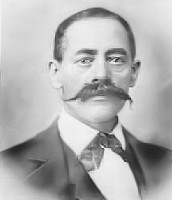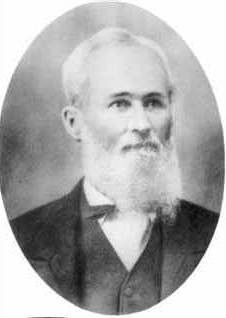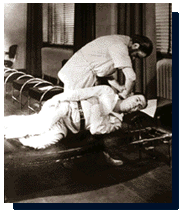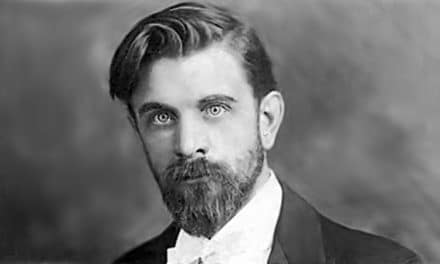Daniel David Palmer established the modern practice of spinal manipulation in the 19th century. He is known as the Father of Chiropractic . Palmer was born on March 7, 1845 in Pickering, Ontario, Canada, to Katherine McVay and Thomas Palmer. When he was twenty, Palmer moved with his family, to the United States where he worked as a beekeeper, farmer, school teacher, and grocery store owner. Palmer had interests in health philosophies and spiritualism.
Magnetic Healing, Palmer’s Precursor to Chiropractic
In 1886, Palmer embarked on a healing practice, opening his first office in the South Putnam Building in Davenport, Iowa. He named the therapy “magnetic healing,” which is a cross between massage and meridian therapy based on the concepts of acupuncture and Chinese medicine. Gaining knowledge from reading medical journals and worldwide developments in anatomy and physiology, he resolved inflammation of the nerves and created remedies.
The Nervous System Affects Health
In Palmer’s first ten years of practice, he questioned MDs about the true causes of diseases, and why people have different diseases, given the same environment. He wanted to know how two people borne of the same parents, living in the same house, breathing the same air, and drinking the same water, had significant health differences, one prone to disease, while the other healthy. Palmer theorized that in addition to external factors, the function of the nervous system was an internal factor that affected a person’s health.
Palmer Cures Deafness with Spinal Manipulation

Harvey Lillard
On September 18, 1895, Palmer discovered his health theory about the nervous system when he met Harvey Lillard, the building janitor, who had been deaf for 17 years. Palmer noticed that Lillard had a lump in his back. When asked about the cause of his hearing impairment, Lillard revealed that when he was in a cramped stooping position while exerting himself, he felt something broke in his back. He then instantly lost his hearing.
Palmer discovered in an examination, that a vertebra was not in its normal position. He theorized that the dislocated vertebra blocked the spinal nerves controlling the inner ear, and that if the vertebra was replaced, the nerve pathways will reopen. After half an hour of convincing Lillard that if the vertebra in his back was replaced, he will regain his hearing, Palmer then applied a firm pressure to Lillard’s back with his hands, using the spinous process as a lever. Soon after, Lillard regained his hearing.
Palmer Restores Heart Condition
Following Lillard’s adjustment, Palmer treated a patient with a heart problem. In an examination of the patient’s spine, a dislocated vertebra was found pressing against the nerves innervating the heart. When the vertebra was replaced, the patient was relieved. These two cases supported his theory, and Palmer rationalized his discovery, that if two different health complications were caused by impinging pressure on the nerves, then other diseases may be caused by the same condition. He then concluded that a partial dislocation of the vertebrae alters its nerve flow, thus causing 95% of all diseases; the rest is caused by dislocated joints apart from the vertebral column. Then began the science (knowledge) and art (adjusting) of Chiropractic.
There was nothing ‘accidental’ about this, as it was accomplished with an object in view, and the result expected was obtained. There was nothing ‘crude’ about this adjustment; it was specific, so much so that no chiropractor has equaled it.
– D.D. Pamer, in Chiropractic: History and Evolution of a New Profession by W. Wardwell
Chiropractic is Born
The word chiropractic was created by Rev. Samuel Weed, fellow resident of Davenport, a friend, and patient to DD Palmer. He combined the Greek words cheiro (hand)

Rev. Samuel Weed
and praktikos (practical or do), creating the term chiropractic, which means “done by hand.”
The Palmer Infirmary & Chiropractic Institute
Originally, Palmer intended to keep his discovery as a family secret, but a year later, he opened a school and spread his method. He had fashioned himself “doctor,” though some people were not convinced of his methods. In 1897, Palmer Infirmary and Chiropractic Institute was formed. In 1904, the school graduated 15 chiropractors. Among the first graduates were Palmer’s son, Barlett Joshua “BJ” Palmer, Andrew P. Davis (MD, DO), William A. Seally (MD), John Howard, Shegataro Morikubo, and Solom M. Langworthy.
The Palmers Prosecuted for Practicing Without a Medical License
In 1899, Heinrich Matthey, a medical doctor in Davenport, Iowa demanded that drugless healers be prevented from practicing in the state, and that education should be entrusted only to doctors of medicine. With the 7th student just graduated from his school, DD Palmer maintained that his graduates did not prescribe drugs, nor test urine or blood. Therefore, his school did not need the same courses or license as medicine, and Palmer refused to get a medical license to exercise his freedom of choice.
Despite Palmer’s insistence that he was not practicing medicine, he was convicted in 1906, along with his son, BJ Palmer, for curing diseases without a license in medicine. He was made to spend 17 days in jail for refusing to pay the fine, but was still made to pay after his release. His son BJ never showed up for the hearing and did not go to jail.
The Chiropractic Curriculum
While DD Palmer was prosecuted for practicing medicine without a license, Solon M. Langworthy created a curriculum of chiropractic study, which focused on the spine and nervous system. Langworthy started referring to the brain as the “life force.” He used the word subluxation to describe the misalignment that narrowed the “spinal windows” (or intervertebral foramina) and interrupted the nerve energy. He published the first book on chiropractic, and brought chiropractic to the scientific field.
Innate Intelligence
Though Palmer disagreed with some of Langworthy’s concepts, Palmer introduced the concept of Innate Intelligence, based on Langworthy’s concepts. Palmer believed innate intelligence was an entity directing the functions of the body using the nervous system to exert its influence.
Palmer School of Chiropractic (PSC)
After DD Palmer’s conviction, he was forced to sell his school to his son, BJ, who was president of the school since 1904. With an arbitration committee, the deal was settled for $2,196.79, and included an assortment of books and specimens from the osteological collection.
The school was then named Palmer School of Chiropractic (PSC), and it is still one of the most prominent chiropractic colleges in the US today. Soon after the turnover, Palmer helped found chiropractic schools in Oklahoma, California, and Oregon.
Under BJ Palmer’s management, PSC expanded its enrollment to over a thousand students in the 1920’s. With each school venturing to establish its own identity, Palmer carried on developing his father’s concept of innate intelligence.
Palmer College of Chiropractic
BJ Palmer improved the methods of spinal adjusting and analysis through extensive research. He included X-Ray imaging technology into the Palmer curriculum, and called it spinography. With Palmer’s aggressive marketing strategies, the standards of chiropractic education increased, and so did the worldwide awareness and appreciation of chiropractic. Palmer School of Chiropractic is now called Palmer College of Chiropractic.
For Chiropractors & Chiropractic Students
Considered by many as one of the most comprehensive books on; chiropractic history, philosophy, neurology, biomechanics, orthopedics, adjusting techniques, rehabilitation, and so much more.
I’m a vegan, entrepreneur, web designer, researcher, and writer. Since becoming a chiropractic patient, I’ve become very passionate about chiropractic. I really enjoy researching and writing articles about chiropractic. Hope you enjoy reading some of them here on Chiropractor.com.





